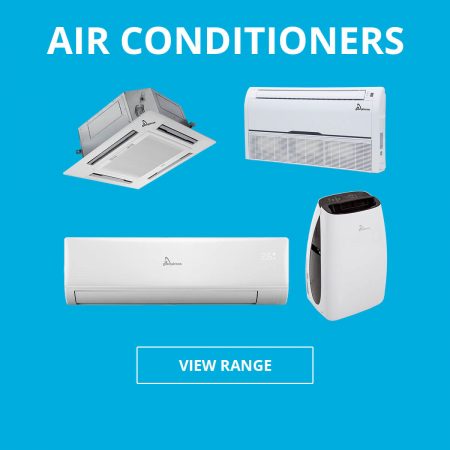Portable air conditioners are easy to use, effective, and especially convenient for small apartments. Because they are easy to move around, you only need one unit in your house, which you can simply take with you from the living room to the bedroom and cool off the room when you need it.
Usually, a portable air conditioning is no larger than a bedside table and can be placed anywhere. The only thing you need to be careful about is being able to connect the duct in the back of the unit to a window so that it can expel hot air outside.
The way a portable AC is working is pretty easy to understand. The portable unit draws warm air from the room, dries it, cools it, and then circulates it back into the room. The hot air is then expelled through the connecting duct. Many portable AC systems can also be used to warm a room during winter or dehumidify it.
Why should I choose a portable air conditioner?
There are plenty of advantages when choosing a portable air conditioner, including:
- Mobility: because the unit is small and easy to move, you won’t have to choose a single room in the house to install it. You can easily carry it around your house and use it to your best convenience. You can keep it in your living room during the day and move it in the bedroom before going to sleep or take it with you in the kitchen while cooking in a hot summer day. You can then store it when you are not using it so that it does not take up floor space
- Costs: portable air conditioners are much more affordable than spit system units, so if you don’t want to make a huge investment, you can easily get away with less than $1000.
- Convenience: if you live in a rental apartment and your landlord does not want to invest in an AC system, a portable AC is your best option. It is affordable, so you won’t be making a huge investment, and you can take it with you when you move, or simply store it somewhere.
Recommended temperature ranges
Portable air conditioning units are always going to be less powerful than central units, but this does not mean your room will not reach the desired temperature. Experts recommend keeping interior temperatures at around 25 °C or below, if possible, so that you feel comfortable regardless of the outside weather.
However, if you are looking for a more exact answer, here are the recommended interior and sleeping temperatures for a range of outdoor temperatures, based on data from The Department of Energy:
If the outside temperature is anywhere between 26.5 and 32°C, then the room temperature should sit at about 25°C while you are awake and 27.8 while you are asleep. If outside temperatures exceed 35°C, then the room temperature can rise above 26°C, so that you won’t feel a huge difference once you step outside.
Ways to increase portable air conditioner efficiency
In those torrid summer days, abusing the “colder” button on your AC may seem like the easiest option, but it’s not always the case. You will not only put a strain on your AC unit, but you will also significantly increase your energy bills. Instead of asking the impossible from you AC, you can develop some habits that help you increase its efficiency while using the same power:
- Block the sun – if your windows are in the sun, close the windows and shut the blinds or curtains. If your windows are in the shade, you can leave curtains open, but make sure the windows are closed.
- Insulate your home: in many cases, the issue with a house that is too cold or too hot can be solved with proper insulation to ensure cold or hot air is kept inside the house.
- Minimize heat production: during hot summer days, if you need to use heat-based appliances, do laundry or cook, it’s best to do so in the morning or during the evening so that you won’t put too much pressure on your AC unit to try and compensate for the heat.
- Use fewer electronics: any device that uses power generates heat, so if you don’t use some of your electronics, it is best to unplug them so that they don’t generate unnecessary heat
